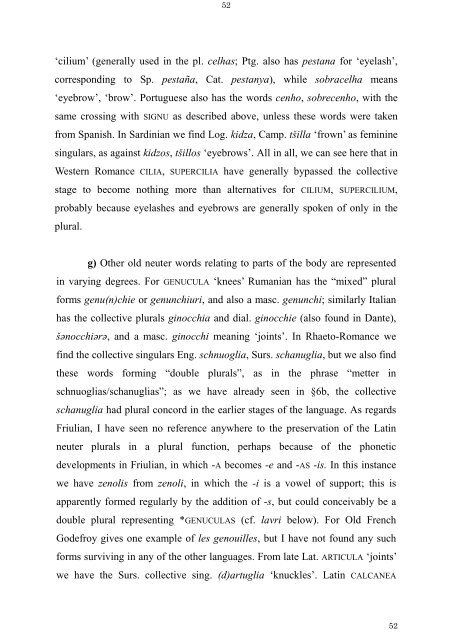The Latin Neuter Plurals in Romance - Page ON
The Latin Neuter Plurals in Romance - Page ON
The Latin Neuter Plurals in Romance - Page ON
You also want an ePaper? Increase the reach of your titles
YUMPU automatically turns print PDFs into web optimized ePapers that Google loves.
52<br />
‘cilium’ (generally used <strong>in</strong> the pl. celhas; Ptg. also has pestana for ‘eyelash’,<br />
correspond<strong>in</strong>g to Sp. pestaña, Cat. pestanya), while sobracelha means<br />
‘eyebrow’, ‘brow’. Portuguese also has the words cenho, sobrecenho, with the<br />
same cross<strong>in</strong>g with SIGNU as described above, unless these words were taken<br />
from Spanish. In Sard<strong>in</strong>ian we f<strong>in</strong>d Log. kidza, Camp. tšilla ‘frown’ as fem<strong>in</strong><strong>in</strong>e<br />
s<strong>in</strong>gulars, as aga<strong>in</strong>st kidzos, tšillos ‘eyebrows’. All <strong>in</strong> all, we can see here that <strong>in</strong><br />
Western <strong>Romance</strong> CILIA, SUPERCILIA have generally bypassed the collective<br />
stage to become noth<strong>in</strong>g more than alternatives for CILIUM, SUPERCILIUM,<br />
probably because eyelashes and eyebrows are generally spoken of only <strong>in</strong> the<br />
plural.<br />
g) Other old neuter words relat<strong>in</strong>g to parts of the body are represented<br />
<strong>in</strong> vary<strong>in</strong>g degrees. For GENUCULA ‘knees’ Rumanian has the “mixed” plural<br />
forms genu(n)chie or genunchiuri, and also a masc. genunchi; similarly Italian<br />
has the collective plurals g<strong>in</strong>occhia and dial. g<strong>in</strong>occhie (also found <strong>in</strong> Dante),<br />
šənocchiərə, and a masc. g<strong>in</strong>occhi mean<strong>in</strong>g ‘jo<strong>in</strong>ts’. In Rhaeto-<strong>Romance</strong> we<br />
f<strong>in</strong>d the collective s<strong>in</strong>gulars Eng. schnuoglia, Surs. schanuglia, but we also f<strong>in</strong>d<br />
these words form<strong>in</strong>g “double plurals”, as <strong>in</strong> the phrase “metter <strong>in</strong><br />
schnuoglias/schanuglias”; as we have already seen <strong>in</strong> §6b, the collective<br />
schanuglia had plural concord <strong>in</strong> the earlier stages of the language. As regards<br />
Friulian, I have seen no reference anywhere to the preservation of the <strong>Lat<strong>in</strong></strong><br />
neuter plurals <strong>in</strong> a plural function, perhaps because of the phonetic<br />
developments <strong>in</strong> Friulian, <strong>in</strong> which -A becomes -e and -AS -is. In this <strong>in</strong>stance<br />
we have zenolis from zenoli, <strong>in</strong> which the -i is a vowel of support; this is<br />
apparently formed regularly by the addition of -s, but could conceivably be a<br />
double plural represent<strong>in</strong>g *GENUCULAS (cf. lavri below). For Old French<br />
Godefroy gives one example of les genouilles, but I have not found any such<br />
forms surviv<strong>in</strong>g <strong>in</strong> any of the other languages. From late Lat. ARTICULA ‘jo<strong>in</strong>ts’<br />
we have the Surs. collective s<strong>in</strong>g. (d)artuglia ‘knuckles’. <strong>Lat<strong>in</strong></strong> CALCANEA<br />
52









